[English] 日本語
 Yorodumi
Yorodumi- PDB-6mwq: Single particle cryoEM structure of a DARPin-aldolase platform in... -
+ Open data
Open data
- Basic information
Basic information
| Entry | Database: PDB / ID: 6mwq | ||||||
|---|---|---|---|---|---|---|---|
| Title | Single particle cryoEM structure of a DARPin-aldolase platform in complex with GFP | ||||||
 Components Components |
| ||||||
 Keywords Keywords | LYASE/FLUORESCENT PROTEIN / synthetic construct / platform / single particle cryoEM / small protein display / LYASE-FLUORESCENT PROTEIN complex | ||||||
| Function / homology |  Function and homology information Function and homology informationnegative regulation of Arp2/3 complex-mediated actin nucleation / fructose-bisphosphate aldolase / fructose-bisphosphate aldolase activity / M band / I band / bioluminescence / glycolytic process / generation of precursor metabolites and energy / protein homotetramerization / positive regulation of cell migration Similarity search - Function | ||||||
| Biological species | synthetic construct (others)  | ||||||
| Method | ELECTRON MICROSCOPY / single particle reconstruction / cryo EM / Resolution: 3 Å | ||||||
 Authors Authors | Weaver, S.J. / Yao, Q. | ||||||
| Funding support |  United States, 1items United States, 1items
| ||||||
 Citation Citation |  Journal: Structure / Year: 2019 Journal: Structure / Year: 2019Title: Fusion of DARPin to Aldolase Enables Visualization of Small Protein by Cryo-EM. Authors: Qing Yao / Sara J Weaver / Jee-Young Mock / Grant J Jensen /  Abstract: Solving protein structures by single-particle cryoelectron microscopy (cryo-EM) has become a crucial tool in structural biology. While exciting progress is being made toward the visualization of ...Solving protein structures by single-particle cryoelectron microscopy (cryo-EM) has become a crucial tool in structural biology. While exciting progress is being made toward the visualization of small macromolecules, the median protein size in both eukaryotes and bacteria is still beyond the reach of cryo-EM. To overcome this problem, we implemented a platform strategy in which a small protein target was rigidly attached to a large, symmetric base via a selectable adapter. Of our seven designs, the best construct used a designed ankyrin repeat protein (DARPin) rigidly fused to tetrameric rabbit muscle aldolase through a helical linker. The DARPin retained its ability to bind its target: GFP. We solved the structure of this complex to 3.0 Å resolution overall, with 5-8 Å resolution in the GFP region. As flexibility in the DARPin position limited the overall resolution of the target, we describe strategies to rigidify this element. #1:  Journal: Biorxiv / Year: 2018 Journal: Biorxiv / Year: 2018Title: Fusion of DARPin to aldolase enables visualization of small protein by cryoEM Authors: Yao, Q. / Weaver, S.J. / Mock, J.Y. / Jensen, G.J. | ||||||
| History |
|
- Structure visualization
Structure visualization
| Movie |
 Movie viewer Movie viewer |
|---|---|
| Structure viewer | Molecule:  Molmil Molmil Jmol/JSmol Jmol/JSmol |
- Downloads & links
Downloads & links
- Download
Download
| PDBx/mmCIF format |  6mwq.cif.gz 6mwq.cif.gz | 474.5 KB | Display |  PDBx/mmCIF format PDBx/mmCIF format |
|---|---|---|---|---|
| PDB format |  pdb6mwq.ent.gz pdb6mwq.ent.gz | 372 KB | Display |  PDB format PDB format |
| PDBx/mmJSON format |  6mwq.json.gz 6mwq.json.gz | Tree view |  PDBx/mmJSON format PDBx/mmJSON format | |
| Others |  Other downloads Other downloads |
-Validation report
| Summary document |  6mwq_validation.pdf.gz 6mwq_validation.pdf.gz | 1.2 MB | Display |  wwPDB validaton report wwPDB validaton report |
|---|---|---|---|---|
| Full document |  6mwq_full_validation.pdf.gz 6mwq_full_validation.pdf.gz | 1.2 MB | Display | |
| Data in XML |  6mwq_validation.xml.gz 6mwq_validation.xml.gz | 85.8 KB | Display | |
| Data in CIF |  6mwq_validation.cif.gz 6mwq_validation.cif.gz | 128.6 KB | Display | |
| Arichive directory |  https://data.pdbj.org/pub/pdb/validation_reports/mw/6mwq https://data.pdbj.org/pub/pdb/validation_reports/mw/6mwq ftp://data.pdbj.org/pub/pdb/validation_reports/mw/6mwq ftp://data.pdbj.org/pub/pdb/validation_reports/mw/6mwq | HTTPS FTP |
-Related structure data
| Related structure data |  9277MC M: map data used to model this data C: citing same article ( |
|---|---|
| Similar structure data |
- Links
Links
- Assembly
Assembly
| Deposited unit | 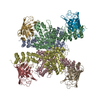
|
|---|---|
| 1 | 
|
| 2 | 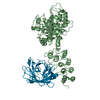
|
| 3 | 
|
| 4 | 
|
- Components
Components
| #1: Protein | Mass: 53113.434 Da / Num. of mol.: 4 Source method: isolated from a genetically manipulated source Details: Rabbit (Oryctolagus cuniculus) muscle aldolase and a synthetic DARPin were fused to create this synthetic construct Source: (gene. exp.) synthetic construct (others), (gene. exp.)  Plasmid: pET21b / Gene: ALDOA Details (production host): C-terminal His-tag of DARPin-aldolase chimeric fusion Production host:  #2: Protein | Mass: 25473.697 Da / Num. of mol.: 4 Source method: isolated from a genetically manipulated source Source: (gene. exp.)   |
|---|
-Experimental details
-Experiment
| Experiment | Method: ELECTRON MICROSCOPY |
|---|---|
| EM experiment | Aggregation state: PARTICLE / 3D reconstruction method: single particle reconstruction |
- Sample preparation
Sample preparation
| Component |
| ||||||||||||||||||||||||
|---|---|---|---|---|---|---|---|---|---|---|---|---|---|---|---|---|---|---|---|---|---|---|---|---|---|
| Molecular weight | Value: 0.314 MDa / Experimental value: NO | ||||||||||||||||||||||||
| Source (natural) |
| ||||||||||||||||||||||||
| Source (recombinant) |
| ||||||||||||||||||||||||
| Buffer solution | pH: 8 | ||||||||||||||||||||||||
| Buffer component |
| ||||||||||||||||||||||||
| Specimen | Conc.: 2.5 mg/ml / Embedding applied: NO / Shadowing applied: NO / Staining applied: NO / Vitrification applied: YES Details: The protein complex was then purified with Ni-NTA affinity chromatography (Qiagen), and Superdex 200 chromatography (GE healthcare). The purified GFP-DARPin-aldolase complex was concentrated ...Details: The protein complex was then purified with Ni-NTA affinity chromatography (Qiagen), and Superdex 200 chromatography (GE healthcare). The purified GFP-DARPin-aldolase complex was concentrated to 2.5mg/ml in a buffer containing 25 mM Tris-HCl pH 8.0 and 150 mM NaCl. | ||||||||||||||||||||||||
| Specimen support | Grid material: GOLD / Grid mesh size: 300 divisions/in. / Grid type: UltrAuFoil | ||||||||||||||||||||||||
| Vitrification | Instrument: HOMEMADE PLUNGER / Cryogen name: ETHANE / Humidity: 95 % / Chamber temperature: 277.15 K Details: Grids were frozen on a manual plunger at the Scripps Research Institute Core Microscopy Facility in a 4 degrees C cold room humidified to >95%. |
- Electron microscopy imaging
Electron microscopy imaging
| Experimental equipment |  Model: Titan Krios / Image courtesy: FEI Company | ||||||||||||||||
|---|---|---|---|---|---|---|---|---|---|---|---|---|---|---|---|---|---|
| Microscopy | Model: FEI TITAN KRIOS | ||||||||||||||||
| Electron gun | Electron source:  FIELD EMISSION GUN / Accelerating voltage: 300 kV / Illumination mode: FLOOD BEAM FIELD EMISSION GUN / Accelerating voltage: 300 kV / Illumination mode: FLOOD BEAM | ||||||||||||||||
| Electron lens | Mode: BRIGHT FIELD / Nominal magnification: 165000 X / Nominal defocus max: 30000 nm / Nominal defocus min: 10000 nm / Cs: 2.7 mm / C2 aperture diameter: 70 µm | ||||||||||||||||
| Specimen holder | Cryogen: NITROGEN / Specimen holder model: FEI TITAN KRIOS AUTOGRID HOLDER | ||||||||||||||||
| Image recording | Imaging-ID: 1 / Average exposure time: 4 sec. / Detector mode: SUPER-RESOLUTION / Film or detector model: GATAN K2 SUMMIT (4k x 4k) / Num. of grids imaged: 1
| ||||||||||||||||
| EM imaging optics | Energyfilter name: GIF Quantum LS / Energyfilter slit width: 20 eV | ||||||||||||||||
| Image scans | Movie frames/image: 40 / Used frames/image: 1-40 |
- Processing
Processing
| EM software |
| |||||||||||||||||||||||||||||||||||||||||||||
|---|---|---|---|---|---|---|---|---|---|---|---|---|---|---|---|---|---|---|---|---|---|---|---|---|---|---|---|---|---|---|---|---|---|---|---|---|---|---|---|---|---|---|---|---|---|---|
| Image processing | Details: Particles from all three microscopy sessions were processed together. | |||||||||||||||||||||||||||||||||||||||||||||
| CTF correction | Details: First whole micrograph correction with CtfFind4. Then per particle CTF Refinement in Relion. Type: PHASE FLIPPING AND AMPLITUDE CORRECTION | |||||||||||||||||||||||||||||||||||||||||||||
| Particle selection | Num. of particles selected: 851776 Details: Manually picked particles were used to generate references for autopicking. Particles from all three microscopy sessions were processed together. Microscope session 1 - 358,381 particles ...Details: Manually picked particles were used to generate references for autopicking. Particles from all three microscopy sessions were processed together. Microscope session 1 - 358,381 particles Microscope session 2 - 64,368 particles Microscope session 3 - 402,427 particles | |||||||||||||||||||||||||||||||||||||||||||||
| Symmetry | Point symmetry: C1 (asymmetric) | |||||||||||||||||||||||||||||||||||||||||||||
| 3D reconstruction | Resolution: 3 Å / Resolution method: FSC 0.143 CUT-OFF / Num. of particles: 236339 / Symmetry type: POINT | |||||||||||||||||||||||||||||||||||||||||||||
| Atomic model building | Protocol: RIGID BODY FIT Details: PDB models 5vy5 and 5ma6 were used as starting points. These models were mutated to match the sequence of the DARPin-aldolase platform in complex with GFP that were used. The PDB models were ...Details: PDB models 5vy5 and 5ma6 were used as starting points. These models were mutated to match the sequence of the DARPin-aldolase platform in complex with GFP that were used. The PDB models were docked into the cryoEM density using Chimera fit into map function. No model refinement was used. | |||||||||||||||||||||||||||||||||||||||||||||
| Atomic model building | 3D fitting-ID: 1 / Source name: PDB / Type: experimental model
|
 Movie
Movie Controller
Controller


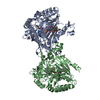
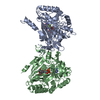

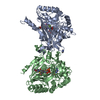
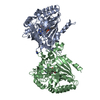
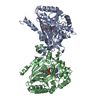
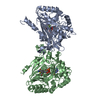

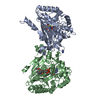

 PDBj
PDBj




